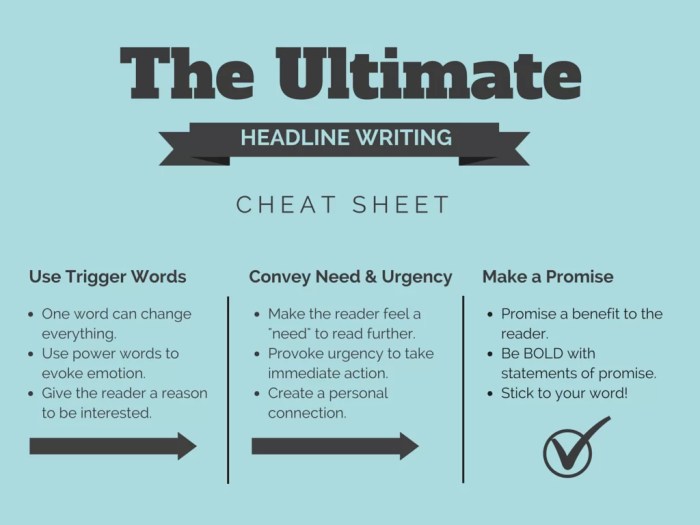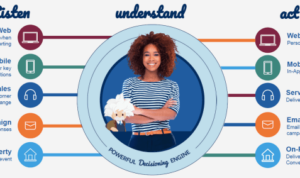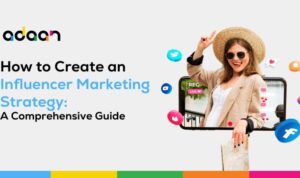Writing Effective Headlines sets the stage for success in content creation, drawing readers in with powerful words and engaging strategies. Dive into the world of captivating headlines that leave a lasting impact.
Explore the ideal length, power words, and creative techniques that make headlines shine, guiding you towards crafting compelling content that resonates with your audience.
Importance of Writing Effective Headlines

Effective headlines are crucial in capturing readers’ attention in a fast-paced digital world where information overload is common. A well-crafted headline can make the difference between someone clicking on an article or scrolling past it.
Impactful headlines can significantly increase click-through rates by generating curiosity, providing a clear benefit or solution, or sparking an emotional response in the reader. They serve as the first impression of your content and can determine whether it gets noticed among the sea of other articles online.
Role of Headlines in and Content Visibility
Headlines play a vital role in (Search Engine Optimization) by helping search engines understand the main topic of your content. A well-optimized headline with relevant s can improve your content’s visibility and ranking in search results.
- s in headlines help match user search queries, increasing the chances of your content appearing in relevant searches.
- Clear and concise headlines make it easier for readers to understand what your content is about, leading to higher engagement and sharing.
- Unique and compelling headlines can set your content apart from competitors, attracting more organic traffic and building brand recognition.
Characteristics of Effective Headlines
When it comes to creating effective headlines, there are certain characteristics that can make a big difference in capturing the reader’s attention and driving engagement. Here are some key factors to consider:
Ideal Length for Headlines
The ideal length for headlines is typically around 6 to 8 words or 50-70 characters. This length is optimal for grabbing the reader’s attention quickly and conveying the main message of the content. Longer headlines can risk losing the reader’s interest, while shorter headlines may not provide enough information. Keeping headlines concise and to the point is essential for maximizing impact.
Using Power Words
Power words are impactful and emotionally charged words that can evoke strong reactions from readers. Incorporating power words into headlines can make them more engaging and compelling. Some examples of power words include: “ultimate,” “exclusive,” “proven,” “unleash,” “revolutionary,” and “discover.” By using these words strategically, you can create headlines that resonate with your audience and drive clicks.
Importance of Clarity and Relevance
Clarity and relevance are crucial when it comes to headline creation. A headline should clearly convey what the content is about and entice the reader to learn more. Avoid using vague or misleading language that may confuse readers. Additionally, ensure that your headlines are relevant to the content they are promoting. Misleading headlines can damage credibility and trust with your audience. By focusing on clarity and relevance, you can create headlines that attract and retain readers.
Types of Headlines: Writing Effective Headlines

When it comes to creating effective headlines, it’s important to consider the different types that can grab the reader’s attention. From listicles to how-tos, each type serves a unique purpose in engaging the audience and driving traffic to your content.
Listicles
Listicles are a popular headline format that presents information in a numbered or bulleted list. They are effective because they promise the reader a specific number of items or tips, making the content easy to digest and share. For example, “Top 10 Ways to Boost Your Productivity” is a compelling listicle headline that entices readers to click and discover valuable insights.
How-Tos
How-to headlines offer practical guidance and step-by-step instructions on a particular topic. They are valuable to readers seeking actionable advice or solutions to their problems. For instance, “How to Master the Art of Public Speaking” is a how-to headline that appeals to individuals looking to improve their communication skills.
Questions
Headlines that pose questions to the reader can spark curiosity and encourage engagement. Questions stimulate the reader’s thinking and prompt them to seek answers within the content. An example of a question headline is “Are You Making These Common Budgeting Mistakes?” which intrigues readers to find out if they are committing financial errors.
Examples of Successful Headlines
– “5 Ways to Transform Your Home on a Budget” (Home Improvement Industry)
– “The Ultimate Guide to Meal Prep for Beginners” (Health and Wellness Industry)
– “Why You Should Invest in Renewable Energy Stocks Now” (Finance Industry)
Effectiveness of Numbers and Emotional Triggers
Using numbers in headlines, such as “5 Tips for Better Sleep,” can attract attention by promising specific, actionable advice. Numbers provide structure and make the content more scannable for readers. On the other hand, incorporating emotional triggers like “Unbelievable Benefits of Meditation” can evoke curiosity and tap into the reader’s emotions, driving them to click and engage with the content.
Crafting Compelling Headlines
Crafting compelling headlines is essential to grab the attention of readers and entice them to click on your content. Here are some strategies to create curiosity in headlines and balance creativity with accuracy:
Creating Curiosity in Headlines
- Use intriguing words or phrases that pique the reader’s interest.
- Pose a question that the reader wants to know the answer to.
- Utilize numbers or statistics to add credibility and draw attention.
- Include a sense of urgency or exclusivity to make readers feel compelled to click.
Balance Creativity with Accuracy, Writing Effective Headlines
- Avoid clickbait tactics that mislead readers just to get clicks.
- Ensure that the headline accurately reflects the content of the article.
- Be creative in your approach while remaining truthful and authentic.
- Use strong language that conveys the value or benefit of reading the content.
A/B Testing Headlines
- Experiment with different headline variations to see which one performs best.
- Test headlines with your target audience to gauge their reaction and engagement.
- Track metrics such as click-through rates and engagement to determine the effectiveness of each headline.
- Adjust and refine your headlines based on the results of A/B testing to optimize for maximum impact.





